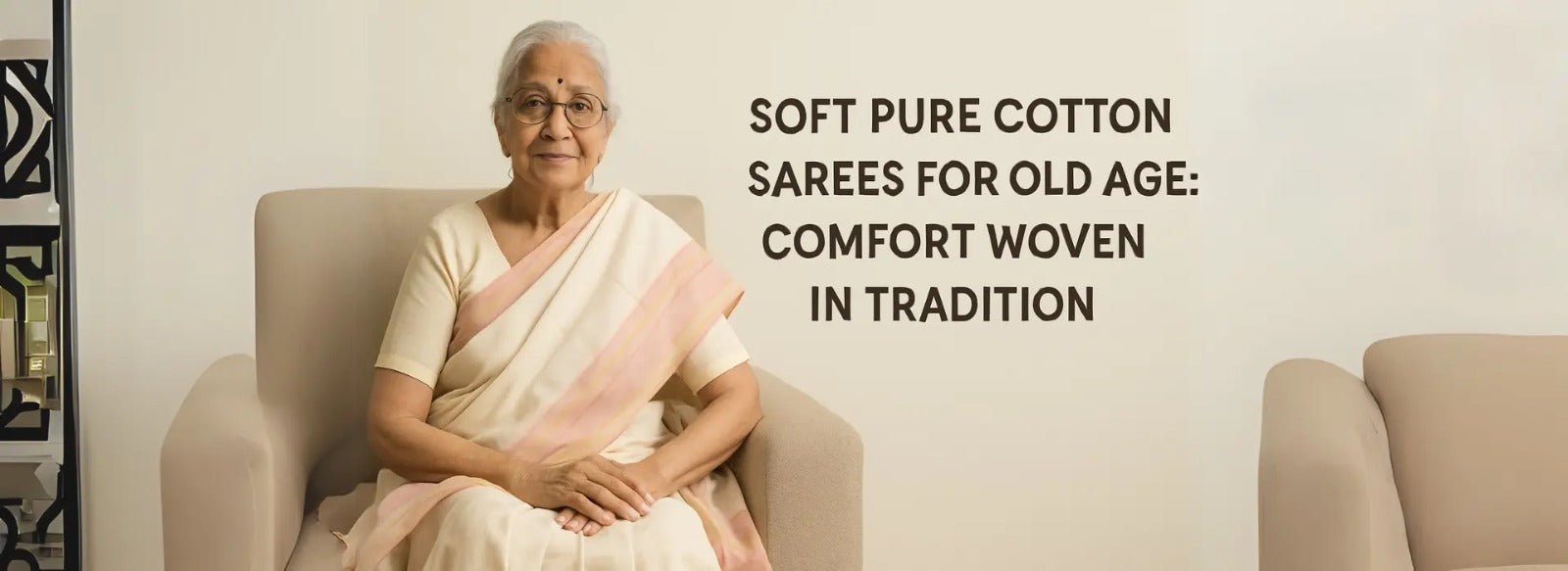Table of Contents
Sarees hold a place in every Indian wardrobe. For older women, the bond with sarees grows deeper. Soft pure cotton sarees for old age remain a staple, not for their design or price, but for their comfort, breathability, and ease of wear. Across Indian homes, older women choose cotton sarees for daily routines, religious gatherings, or casual family functions.
The choice of saree material evolves. Soft pure cotton sarees are reliable when comfort is prioritized over fashion. These sarees allow air to circulate. They absorb moisture. They stay light on the skin. In tropical climates, these qualities matter.
Older women often select these sarees not from stores, but from experience. Soft pure cotton sarees for old age are more than an outfit. They are part of personal habits. They reflect a lifestyle rooted in simplicity and ease.
Cotton as a Companion in Old Age
Cotton stands as one of the oldest fabrics in human history. India leads as a producer and wearer of cotton textiles. Cotton sarees occupy the front row in wardrobes among senior citizens, especially women. These sarees follow them through daily prayers, evening strolls, and social conversations.
Pure cotton sarees offer practical benefits. They handle daily washing without fading fast. The fabric softens over time. Unlike synthetic materials, cotton does not cling to the skin. During humid months, the saree does not trap heat.
For older women, skin sensitivity grows with age. Cotton reduces irritation. The natural fiber aligns with skin that demands less friction. It also helps in temperature regulation. During the summer months, soft pure cotton sarees offer a cooling effect. During winter, they allow layering without discomfort.
Traditional Weaves That Suit Old Age
India's regional handlooms give cotton sarees their diversity. Bengal's Tant, Andhra Pradesh's Mangalgiri, Tamil Nadu's Koorainadu, and Maharashtra's Khun are all popular cotton saree varieties among older women.
Tant sarees are light. Their loose weave lets the skin breathe. Koorai sarees, though sometimes mixed with silk, retain cotton's breathability when woven in pure form. Spin from handwoven cotton; Khadi sarees are especially preferred for their texture, which softens further with each wash.
For old age, soft pure cotton sarees usually avoid excessive zari or embroidery. Simplicity in the weave allows freedom of movement. Seniors appreciate the ease of draping, especially for long durations.
Sarees and Mobility: Why Cotton Fits the Lifestyle
Old age often brings limited mobility. Soft pure cotton sarees have become a practical option for women who prefer not to adjust their outfits constantly. The material stays in place after draping. It does not slip easily like satin or chiffon.
Most older women choose cotton for home wear. The saree moves with the body. Its drape holds even when sitting, bending, or walking. The ease of maintaining this fabric adds to its appeal. After a wash, the saree needs minimal attention apart from basic ironing.
In social spaces, older women prefer cotton sarees for their understated grace. The look is appropriate for family gatherings and neighborhood errands when paired with a simple blouse. Cotton does not demand accessories. It carries its identity quietly.
The Role of Climate in Cotton Saree Popularity
India's climate pushes cotton into daily use. Older women turn to soft pure cotton sarees in hot and humid states as an automatic choice. Cotton absorbs sweat. It allows the skin to stay dry. During power cuts or monsoon seasons, the fabric's natural properties help women manage changing temperatures.
In rural and urban settings, older women wear these sarees during chores. Whether tending to plants or making morning tea, the saree adjusts. In states like Kerala, the white cotton saree with a gold border, called Kasavu, remains the preferred everyday garment for many older women.
Even during travel or pilgrimages, cotton sarees pack light and wash easily when comfort and convenience lead; soft pure cotton sarees stand at the top.
Maintenance: An Added Advantage
Maintenance decides wardrobe choices for many older women. Soft pure cotton sarees for old age fit this need. They can be hand-washed or machine-washed. The fabric dries fast. It does not demand dry cleaning, unlike silk or synthetic blends.
The longevity of cotton sarees also appeals to this age group. A well-maintained cotton saree can last years. Even after visible fading, the saree often transitions from public to home wear.
For those who prefer natural dyes or chemical-free fabrics, cotton sarees offer options. Small handloom stores across India continue to produce vegetable-dyed cotton sarees in traditional patterns.
A Symbol of Familiarity and Comfort
As women age, the value of clothing shifts from trend to comfort. Soft pure cotton sarees reflect this shift. These sarees do not follow the fast-changing fashion cycle. They stand as symbols of routine, comfort, and identity.
Older women often develop a strong attachment to their cotton sarees. The saree carries memories of family gatherings, festivals, and personal milestones. The tactile comfort of cotton has become familiar over decades.
In many Indian households, sarees pass from one generation to another. A cotton saree worn by a grandmother might one day become a cherished family piece. In this way, soft pure cotton sarees for old age remain connected to the past and the future.
Soft pure cotton sarees for old age offer more than just clothing. They provide ease, breathability, and practicality. These sarees fit the daily rhythm of older women's lives, giving mobility without sacrifice. As lifestyles slow down and skin grows sensitive, cotton remains a reliable companion.
Whether worn during household chores, community gatherings, or religious rituals, the cotton saree continues to hold its place. It moves with the wearer, adapts to the climate, and lives through the years. Comfort shapes the decision. Tradition follows quietly.




